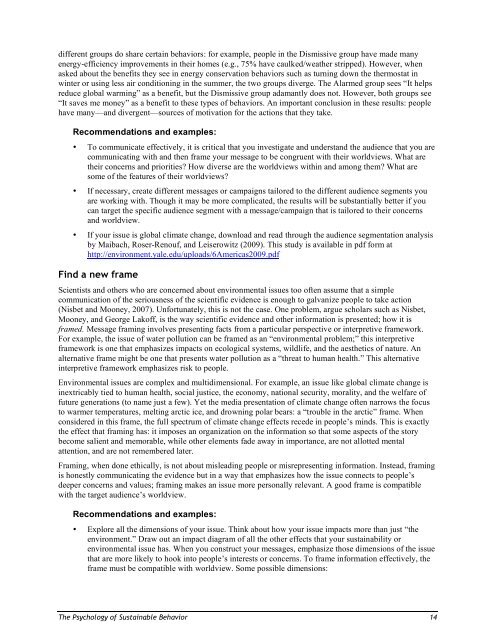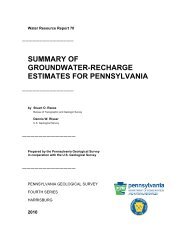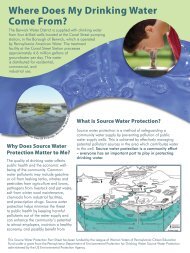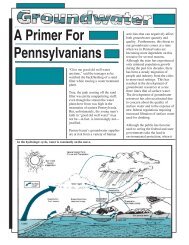The Psychology of Sustainable Behavior - Minnesota Pollution ...
The Psychology of Sustainable Behavior - Minnesota Pollution ...
The Psychology of Sustainable Behavior - Minnesota Pollution ...
You also want an ePaper? Increase the reach of your titles
YUMPU automatically turns print PDFs into web optimized ePapers that Google loves.
different groups do share certain behaviors: for example, people in the Dismissive group have made many<br />
energy-efficiency improvements in their homes (e.g., 75% have caulked/weather stripped). However, when<br />
asked about the benefits they see in energy conservation behaviors such as turning down the thermostat in<br />
winter or using less air conditioning in the summer, the two groups diverge. <strong>The</strong> Alarmed group sees “It helps<br />
reduce global warming” as a benefit, but the Dismissive group adamantly does not. However, both groups see<br />
“It saves me money” as a benefit to these types <strong>of</strong> behaviors. An important conclusion in these results: people<br />
have many—and divergent—sources <strong>of</strong> motivation for the actions that they take.<br />
Recommendations and examples:<br />
• To communicate effectively, it is critical that you investigate and understand the audience that you are<br />
communicating with and then frame your message to be congruent with their worldviews. What are<br />
their concerns and priorities? How diverse are the worldviews within and among them? What are<br />
some <strong>of</strong> the features <strong>of</strong> their worldviews?<br />
• If necessary, create different messages or campaigns tailored to the different audience segments you<br />
are working with. Though it may be more complicated, the results will be substantially better if you<br />
can target the specific audience segment with a message/campaign that is tailored to their concerns<br />
and worldview.<br />
• If your issue is global climate change, download and read through the audience segmentation analysis<br />
by Maibach, Roser-Renouf, and Leiserowitz (2009). This study is available in pdf form at<br />
http://environment.yale.edu/uploads/6Americas2009.pdf<br />
Find a new frame<br />
Scientists and others who are concerned about environmental issues too <strong>of</strong>ten assume that a simple<br />
communication <strong>of</strong> the seriousness <strong>of</strong> the scientific evidence is enough to galvanize people to take action<br />
(Nisbet and Mooney, 2007). Unfortunately, this is not the case. One problem, argue scholars such as Nisbet,<br />
Mooney, and George Lak<strong>of</strong>f, is the way scientific evidence and other information is presented; how it is<br />
framed. Message framing involves presenting facts from a particular perspective or interpretive framework.<br />
For example, the issue <strong>of</strong> water pollution can be framed as an “environmental problem;” this interpretive<br />
framework is one that emphasizes impacts on ecological systems, wildlife, and the aesthetics <strong>of</strong> nature. An<br />
alternative frame might be one that presents water pollution as a “threat to human health.” This alternative<br />
interpretive framework emphasizes risk to people.<br />
Environmental issues are complex and multidimensional. For example, an issue like global climate change is<br />
inextricably tied to human health, social justice, the economy, national security, morality, and the welfare <strong>of</strong><br />
future generations (to name just a few). Yet the media presentation <strong>of</strong> climate change <strong>of</strong>ten narrows the focus<br />
to warmer temperatures, melting arctic ice, and drowning polar bears: a “trouble in the arctic” frame. When<br />
considered in this frame, the full spectrum <strong>of</strong> climate change effects recede in people’s minds. This is exactly<br />
the effect that framing has: it imposes an organization on the information so that some aspects <strong>of</strong> the story<br />
become salient and memorable, while other elements fade away in importance, are not allotted mental<br />
attention, and are not remembered later.<br />
Framing, when done ethically, is not about misleading people or misrepresenting information. Instead, framing<br />
is honestly communicating the evidence but in a way that emphasizes how the issue connects to people’s<br />
deeper concerns and values; framing makes an issue more personally relevant. A good frame is compatible<br />
with the target audience’s worldview.<br />
Recommendations and examples:<br />
• Explore all the dimensions <strong>of</strong> your issue. Think about how your issue impacts more than just “the<br />
environment.” Draw out an impact diagram <strong>of</strong> all the other effects that your sustainability or<br />
environmental issue has. When you construct your messages, emphasize those dimensions <strong>of</strong> the issue<br />
that are more likely to hook into people’s interests or concerns. To frame information effectively, the<br />
frame must be compatible with worldview. Some possible dimensions:<br />
<strong>The</strong> <strong>Psychology</strong> <strong>of</strong> <strong>Sustainable</strong> <strong>Behavior</strong> 14













